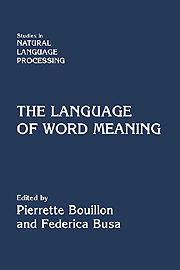Book contents
- Frontmatter
- Contents
- List of Contributors
- Preface
- Introduction: Word Meaning and Creativity
- Part I Linguistic Creativity and the Lexicon
- Part II The Syntax of Word Meaning
- Part III Interfacing the Lexicon
- Part IV Building Resources
- 18 Introduction
- 19 Generative Lexicon and the SIMPLE Model: Developing Semantic Resources for NLP
- 20 Lexicography Informs Lexical Semantics: The SIMPLE Experience
- 21 Condensed Meaning in EuroWordNet
- Index
19 - Generative Lexicon and the SIMPLE Model: Developing Semantic Resources for NLP
Published online by Cambridge University Press: 07 October 2011
- Frontmatter
- Contents
- List of Contributors
- Preface
- Introduction: Word Meaning and Creativity
- Part I Linguistic Creativity and the Lexicon
- Part II The Syntax of Word Meaning
- Part III Interfacing the Lexicon
- Part IV Building Resources
- 18 Introduction
- 19 Generative Lexicon and the SIMPLE Model: Developing Semantic Resources for NLP
- 20 Lexicography Informs Lexical Semantics: The SIMPLE Experience
- 21 Condensed Meaning in EuroWordNet
- Index
Summary
Abstract
In this paper, we present recent extensions of Generative Lexicon theory (Pustejovsky, 1995; Pustejovsky, 1998) in the context of the development of large-scale lexical resources for twelve different European languages: the SIMPLE model.
The development of lexical resources must be guided by an underlying framework for structuring word meaning and generating concepts, which satisfies both onto logical considerations as well as the need to capture linguistic generalizations. The model presented here is a proposal toward this goal.
Introduction
The development of formal frameworks for computational lexical semantics should respond to two needs: capturing the richness of language as revealed in both meaning variation and systematic polysemy, and providing a viable and testable model for building large-scale lexical resources for natural language processing.
In this paper, we address these topics from the dual perspective of theory and applications. The theoretical aspect motivates a generative framework for structuring and generating concepts. The practical aspect focuses on the implementation of the GL-based framework within the EU-sponsored SIMPLE project, which involves the development of harmonized large-scale semantic lexicons (10,000 word senses) for twelve different languages.
- Type
- Chapter
- Information
- The Language of Word Meaning , pp. 333 - 349Publisher: Cambridge University PressPrint publication year: 2001
- 3
- Cited by



